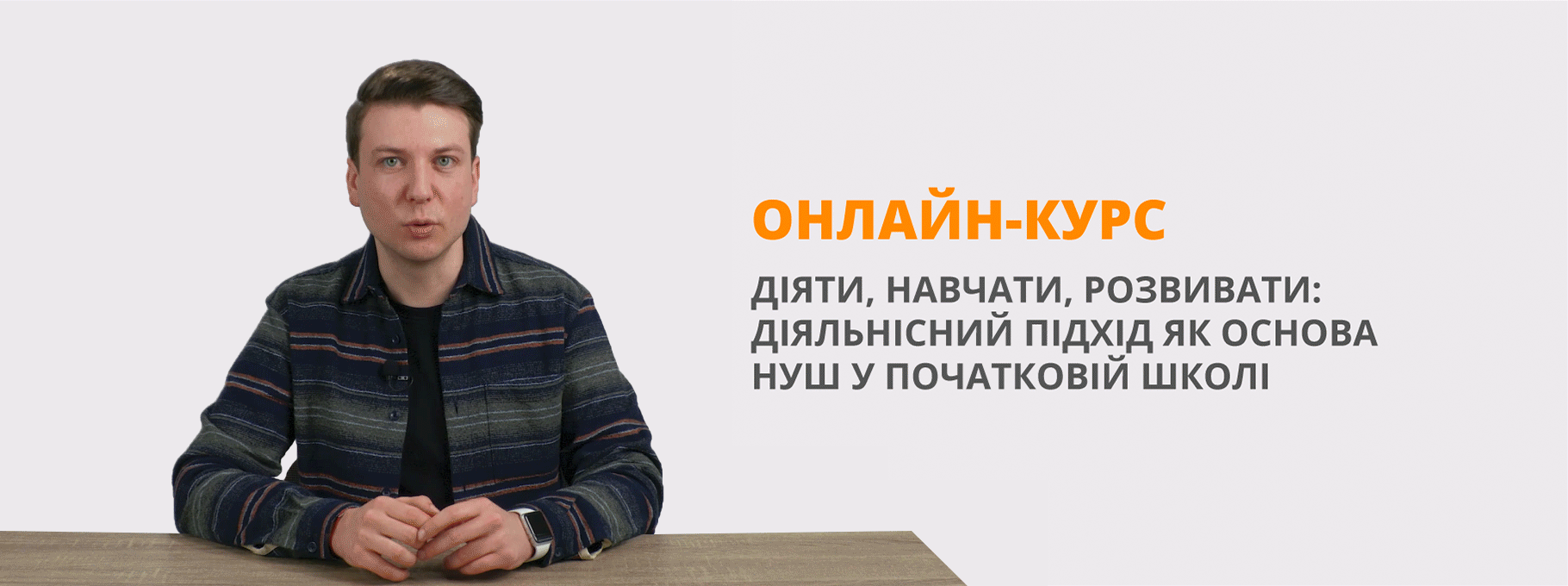Конспект уроку у 4 класі на тему "Holidays and Traditions"
Topic: Holidays and Traditions
Subtopic: Birthday Party Celebration
The aim of the lesson: to develop students’ critical and creative thinking by learning about holidays and celebrations in Ukraine and abroad.
Objectives:
To encourage students to: communicate about birthday celebrations in Ukraine and abroad; use English effectively for study purpose;
to practice role-plays about planning a birthday celebration; to classify birthday celebrations in Ukraine and abroad, to choose information to write an invitation; to use the structure I’d like to..; to select specific information while watching a video.
Outcomes of the lesson
By the end of the lesson students will be able to: explain the difference in celebrating birthdays in Ukraine and abroad; describe their birthday party; write an invitation card; apply their knowledge in real situations.
Language Support Resources: SB, WB, CD, a tape-recorder, copy-books, pictures, flash cards (speech patterns), grammar basic tables.
Procedure
I. Organizing moment.
T: Are you ready for the lesson?
Cl: Yes, we are.
T: I’m glad to see you.
Cl: We are glad to see too.
T: Greet our guests, please.
Cl: You are welcome to our school
We are sure it will be cool!
- Warming up
T: How are you today?
P1: I’m exited. My mum bought me a new phone yesterday.
T: Lucky you are! What about you?
P2: I’m wonderful! Everything is OK.
T: And you?
P3: I’m astonished. I didn’t expect so many guests at our lesson.
T: Don’t worry. Everything will be fine. Solomia, you look great today?
P4: Thank you. I’m overjoyed. My youngest brother is one month old today.
T: Oh, my congratulations. What about you?
P5: I’m glad. Winter isn’t over and I can play snowballs and sledge.
T: How do you do?
P6: I’m optimistic. I hope to get 12 today.
T: And you?
P7: I’m hot. It’s the warmest classroom.
T: You are right. How are you?
P8: I’m surprised. We have a lot of work today.
T: And you?
P9: I’m happy. I’m going to visit my granny at the weekend.
T: What about you?
P10: I’m terrific. I like going to school. And I’m glad our holidays are over.
T: And you?
P11: I’m diligent. I did all the hometask for today.
T: What about you?
P12: I’m thankful. Every day I give thanks to God foe everything he gives us.
III. Phonetic drill.
T: If you want to have a good English pronunciation, you must drill the sounds.
So, watch and repeat. (A video “Double phonics”).
IV. Lead-in.
T: Now, look at the blackboard. Guess, what we are going to do at our lesson.
P1: We are going to watch a video.
T: Why do you think so?
P1: I think so, because I see a TV.
P2: We are going to write the words, because I see encoded words.
T: Yes, today we’ll talk about your favorite party, especially about a birthday party, the traditions of celebrating it in Ukraine and abroad. You know that you often bring flowers to a birthday party. So, today this magic flower has a lot of different tasks for you, and if you do it successfully you’ll get some presents. At the end of the lesson you’ll count your presents and get marks. One present is two points. If you have 16-14 points, your mark is 12, 12 points your mark is 11, 10 points – 10, 8 points your mark is 9.
V: Brainstorming
1) “A snow ball game” ( Icebreaker game)
T: It’s winter now. It’s high time to play snowballs. Stand in a circle. Your task is to name one party word and toss a ball to your friend. You’ll repeat this word and add your own one.
T: Great. You have a very good memory.
- Look at the blackboard. Here we have pictures and scramble words. Decode the words and write them under the pictures on the blackboard and on the papers on your desks. (cake, candles, dancing, games, presents, food, friends, sweets, flowers, fun, postcards, wishes).
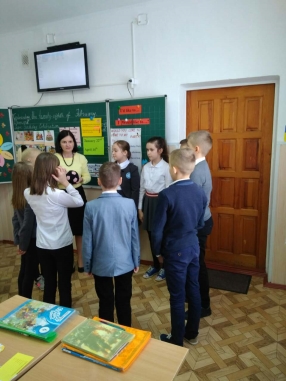
T: Repeat the words all together.
Now say what you would like to do at the birthday party. Use the model on the blackboard I’d like to…
P: I’d like to have a big birthday cake.
- I’d like to dance at my birthday party.
- I’d like to play interesting games at my birthday party.
- I’d like to get a lot of presents for my birthday party.
- I’d like to have tasty food at my birthday party.
- I’d like to invite a lot of friends.
- I’d like to buy a lot of sweets for my birthday party.
- I’d like to get a lot of flowers for my birthday party.
- I’d like to have a lot of fun at my birthday party.
- I’d like to get good wishes at my birthday party.
- I’d like to receive postcards from my friends.
P: I’d like to have a big birthday cake.
T: Look at our model once more. How can we make questions with this structure?
P: We have to put it in the beginning.
T: Ask and answer questions about the parties. Use the model “Would you like to…?”
P1: Would you like to have a big birthday cake? - Yes, I would.
- Would you like to have nine candles on your cake? – No, I wouldn’t. I’d like to have ten candles.
- Would you like to sing karaoke? – Yes, I would.
- Would you like to invite a clown at your birthday party? - Yes? I would.
- Would you like to celebrate your birthday at the Sky Up? –No, I wouldn’t. I’d like to celebrate it at the Fly Kids.
- Would you like to have a lot of fun? – Yes, I would.
- Would you like to get a lot of flowers? –Yes, I would.
- Would you like to get a lot of presents? – Yes, I would.
- Would you like to buy a lot of sweets for your guests? –No, I wouldn’t. I don’t like sweets.
- Would you like to buy a new dress for your birthday party? –Yes, I would.
- Would you like to help your mum? –Yes, I would.
VI: Relaxation
T: Are you tired?
Cl: Yes, we are.
T: Let’s sing a song.
VII. Reading Activity.
T: You need to do a lot of things to organize a good birthday party. One of them is to write an invitation card. It isn’t easy. So today we’ll learn how to do it. Open your PB p.94
Now look at the picture. Tell me what is it? (It’s an invitation) Who is it from? (It’s from Kelly and Jack) Who is it from/ to? (It’s to Roz)
- What is an occasion? (A Welcome Home Picnic for Kelly and Jack)
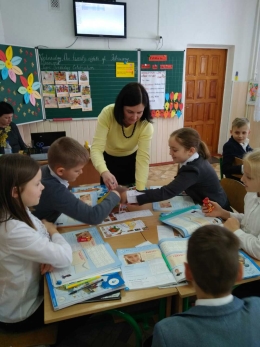
T: Now read the invitation and Roz’s email to find the answers to the questions.
2. Where is the party? at Greenwoods Park
3. What time is it? at 3 o'clock
4. Is Roz going to go? Yes, she is.
5. Is she going to take anything to the picnic? She’s going to take sandwiches, crisps and juice.
T: Nice of you! But pay attention to writing dates. Look at the blackboard January 22nd April 14th.
Look again at Kit’s invitation and at Roz’s email and find three dates. Write the dates in the correct order according to number of a month and date on the blackboard. Work in groups so you can help each other. i.e. May 22nd , August 3rd , August 8th.
Let’s check. Who wants to go to the blackboard and put the numbers in order.
VIII. Writing Activity.
T: Look at the invitation on the blackboard. Let’s do it orally at first.
Would You Like to Come to the Party?
To_________________
The Occasion__________________________
The Time_____________________________
The Date______________________________
The Place______________________________
Tel:___________________________________
From__________________________________
Now, your task is to write your own invitations. Take pieces of papers and fill in.
T: Are you ready? Put your invitations into the envelopes on your desks. I’ll check them later.
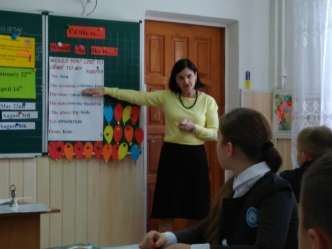
IX. Role Play.
T: Now you know how to invite your friends to a birthday party. The next step is to plan it. Your home task was to learn the dialogue about preparing to a party.
- "Hi, Vika. What are you doing?"
- "Hi, Solomia. I'm planning my birthday party."
-"How is that going?"
- "Not well. I can't think of anything to do."
- "How many kids do you want to invite?"
- "I wants to invite three girls from our class."
- "And boys?"
- " And 5 boys of course. They are my best friends, you know."
- "How about an outdoor party?"
- "We did that last year and it rained."
- "Oh. That's not fun."
- "I was thinking about taking my friends to the Fly Kids center."
- "It’s a great idea! We’ll have a lot of fun there."
- "My mum promised me to invite a magician."
- "Very nice! Everybody likes tricks. That sounds like a great party."
- "Thanks for your help."
X. Relaxation A song ”Shake your hands”.
XI. Listening Activity.
1) Pre-Listening Activity
T: It’s high time to visit a party. But at first let’s prepare for it. Chinese whispers:
At first let’s join into new groups. Take a sweet from my bag. So, we have two teams: pink and green. Students stand in two lines. I whisper a word to the first in the line who whispers it on to the next in line, and so on until the last student in the line shouts out the word you hear and write the word on the board.
Words: party, balloons, cake, decorate, play games, get a prize, present, have a good time, computer games, clothes, make a wish, come true
T: Look at these words and guess what is the story about we are going to listen to?
T: Now your task is to watch and listen to a story. But pay attention to some words.
Gift means a present. It’s an American word.
Streamers mean a long, narrow strip of material used as a decoration.
Pop drink means fizzy drink, such as coca-cola.
T: Watch a story attentively.
2) Post-Listening Activity
Now complete the sentences choosing the right variant.
Now complete the sentences choosing the right variant.
1. My friend Jane had her … birthday.
a) ninth
b) tenth
c) eleventh
2. The house was decorated with …
a) balloons and streamers
b) flowers
c) posters
3. There were ten …on the cake.
a) flowers
b) dolls
c) candles
4. At the party we …
a) played some games
b) swam in the river
c) played hide-and-seek.
5. She got…
a) some dolls
b) some books
c) some clothes and computer games
6. We ate…
a) hot-dogs, a cake and some ice-cream
b) pizza and sweets
c) potatoes and fruit.
T: Now watch the questions and answer them.
1. What was the house decorated with?
2. How many candles there were on the cake?
3. Where did they swim?
4. What did they have to drink?
5. What did they do before they went home?
T: Watch the questions and answer them.
1. What was the house decorated with?
2. How many candles there were on the cake?
3. Where did they swim?
4. What did they have to drink?
5. What did they do before they went home?
XII. Production
T: Now, let’s compare birthday celebrations in Ukraine and abroad. Take a balloon from the blackboard, read it and stick in Ukraine or abroad or in the middle if the tradition is the same. Use the words to express your opinions.
Ukraine
Home-made dinner
Home-made cake
Not to congratulate beforehand
To cook a lot of meals
To pull the ears
Abroad
Write a letter to a child
Take a birthday interview
Decorate a car
Decorate a mirror
Put streamers on the bedroom door
The same
Give presents on the birthday
Have a birthday cake with candles
Decorate a place of celebration
Invite guests
Make wishes
|
Ukraine In Ukraine people usually celebrate birthday at home. They prepare a delicious home-made dinner. Also mums or grandmas cook a home-made cake. In our country there is a tradition to cook a lot of food for a party. Ukrainians are happy when their table bursts with food. I want to add that we don’t congratulate people beforehand. We believe that it brings bad luck. To finish with Ukrainians have an old tradition to pull the ears and count the years. |
|
Abroad I want to say that people like to have parties abroad as well as in Ukraine. But there is some difference. Parents abroad write a letter to a child and tell that they love him and wish a lot of happiness. Also there’s a tradition to take a birthday interview. Sometimes parents decorate a mirror and write special wishes on it. But what I like the most is decorating parents’ car. Children have a lot of fun painting pictures on it. Also parents put streamers on the bedroom door. I think it’s a surprise to see them in the morning. |
|
The same I’m sure that there’s no big difference in celebrating birthdays in Ukraine and abroad. We have a lot in common. Before a party people decorate a place of celebration. They invite guests and have a big birthday cake with candles. The tradition to blow out the candles and make a wish is the same. I think that one of the pleasant things is giving presents and wishing many happy returns of the day. Children are fond of playing games and singing karaoke. To finish with a birthday party is one of the most popular celebrations in the world.
|
|
Some weeks ago I had a party. It was my tenth birthday. I had a birthday cake with ten candles on it. I blew out the candles and made a wish. We had a lot of fun. There were a lot of streamers all around. The food was very tasty. I got a lot of presents. It was the best party I’ve ever had.
|
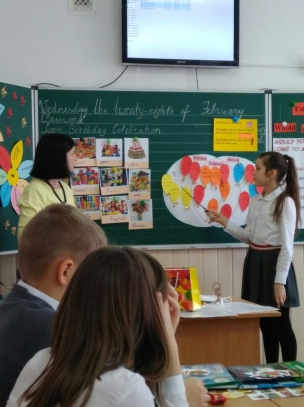
XIII. Reflection
T: Do you like our lesson? What tasks were the easiest for you? Stick your butterflies on the parts of the lesson you liked the most. What tasks were the most difficult?
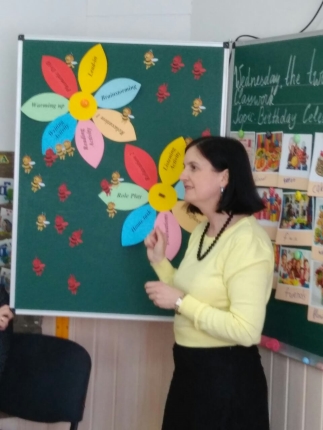
XIV. Evaluations.
XV. Home task.
T: You often have your parties outdoor. There is a lot of rubbish after such celebrations. How should we do with it? (We should put rubbish into a bin. We shouldn’t throw it around. We should separate paper, glass, plastic from food.) Your hometask is to write what we should do with rubbish. AB ex.5, 6 p. 93 – match the parts of the sentences and fill in the dialogue.
Список використаних джерел:
1. Jeanne Perrett, Charlotte Covill, Fly High 4 Pupil's Book, Pearson-Longman, 2011 - p.94-95
2. Johns Hopkins, Cogwheels of the Mind: The Story of Venn Diagrams, 2004
3. https://www.youtube.com/watch?v=EAPmy1SxDdQ


про публікацію авторської розробки
Додати розробку
